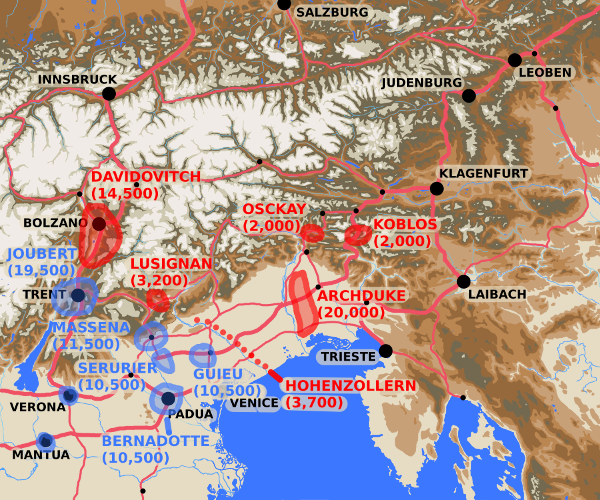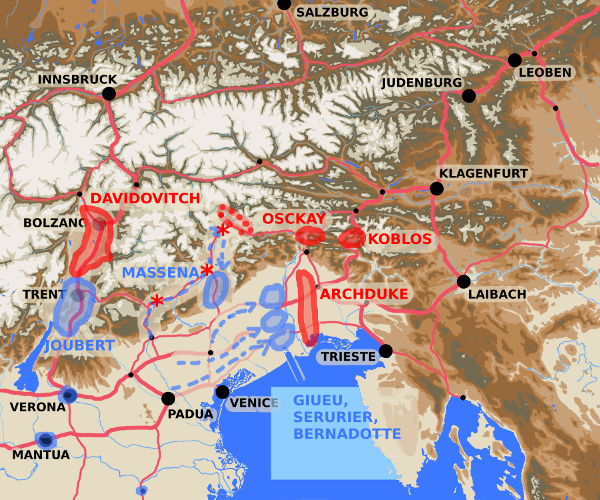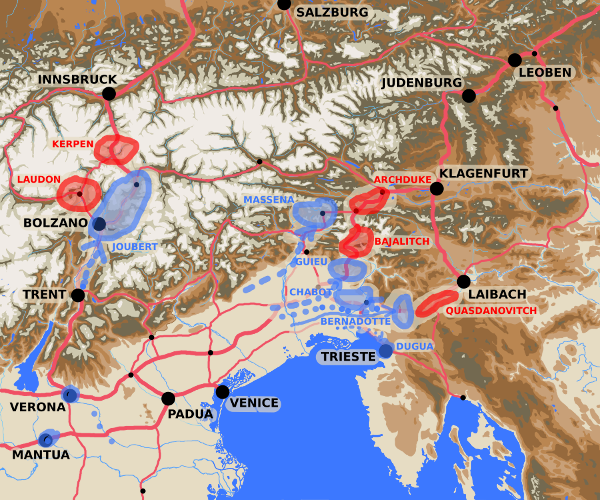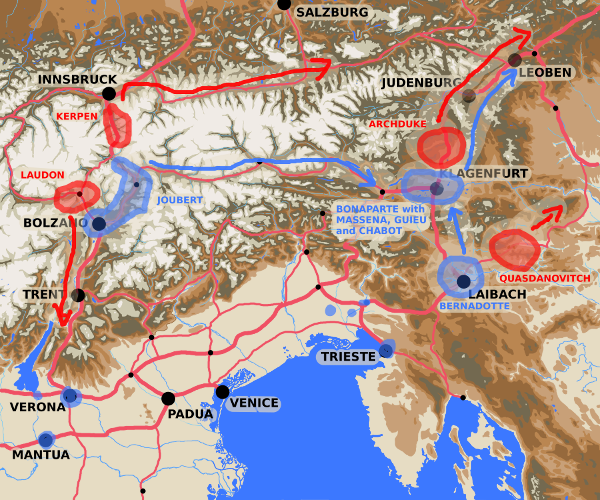Napoleon Bonaparte's Army of Italy crosses the Alps into Austria.
A Map showing the theatre of operations.

Note: To avoid clutter the Isonzo, Save and Drava rivers are not marked on the map. The Isonzo runs north-south from the sea past Goriza to Tarvisio, the Save runs east-west past Laibach, and the Drave runs east-west past Klagenfurt and Villach. Also the Mur runs past Graz and Bruck.
If war is the continuation of politics by other means than it's odd Bonaparte's campaign against the Austrian's now under the Archduke Charles in the spring of 1797 receives as little attention as it does. Mostly, however, it's treated as a quick footnote to the earlier part of his first Italian campaign.
This is odd because although Bonaparte had been militarily victorious against a succession of Austrian armies and that under the Archduke was no match for him on a higher strategic political level his situation was not that good.
The Austrian government saw no reason it should surrender and make peace because of Bonaparte's successes in Italy. Success in Italy did not mean success against Austria in Germany. Attacking the Austrian homeland over the Alps from Italy was not a strategically sound or even plausible idea.
It was not strategic blindness or incompetance that made the French government see Italy as a diversion and a sideshow to a main effort against Austria via Germany, over the Rhine and down the Danube, it was common sense.
This all the more true in that a united Italy itself was a match for the French forces there. And Italy was restive. Although divided geographically and socially, the looting and pillage both by the common French soldiary and by agents of the French government was creating wide opposition throughout French dominated Italy. Some actors like the Pope had never ceased to oppose the French to the greatest degree they could.
So an attack on the seat of the Austrian government was far fetched in its own right, doing so with Italy about to revolt in the French rear made it dangerously unlikely. The French Army of Italy ran the risk of being stranded in the barren cold Alps with the Austrians, newly strengthened from Germany and defending their homeland behind mountain barriers, in front of them, and Italy having risen in revolt behind them. It was a recipe for disaster.
These problems, a recalcitrant Austrian government and a restive Italy were anything but purely military ones, they had a large political component.
Even before Mantua had fallen on February the 2nd Bonaparte had moved south to secure the Papal States. With a detachment of 10,000 men, partly newly raised Italians, he swept aside resistance by local rebels and the small Papal army alike. By the 19th he was dictating new terms to the Pope with the Treaty of Tolentino. A third of the Papal States including Bologna, Ferrara and the Romagna were surrendered to the French. Heavy new contributions were laid on the Papal States, Tuscany and Venice were made to pay substantial sums too. Bonaparte was back in Bologna from the 24th to the 27th of February where he issued a spat of orders preparing his army for the coming campaign. He was back in Mantua by the 2nd of March.
A Map showing the theatre of operations with army strengths at start of campaign that is March 10th.

Even before Bonaparte had returned preliminary operations had cleared the Brenta valley between Trent and Bassano. This allowed direct communications between a defacto Corps under Joubert guarding the Tyrol and Messana's division of the forces under Bonaparte's direct control. Joubert had about 20,000 men and Bonaparte about 40,000.
They were opposed by widely scattered and demoralized forces under the Archduke Charles. The Archduke against his better wishes had been directed to directly defend Fruili and in particular the valuable city of Trieste. He had six brigades of roughly 4,000 men each for about 24,000 in total for this task. One brigade out in front under Hohenzollern composing a screen on the Piave, the bulk strung out along the Togliamento river. Various detachments guarded the Alpine passes. The divisions of Laudon and Kempen were in the Tyrol under Davidovitch guarding the path to Innsbruck with about 14,000 men. A few thousand men each were at Feltre under Lusignan, in the Togliamento gorges south of Pontebba under Osckay, and in the Isonzo gorges south of Tarvisio under Koblos.
As dire as it was the Austrian situation improving day by day especially in the Alpine areas closest to the Austrian homeland as new reinforcements arrived. Bonaparte had good reason to strike as soon as he was able.
So the French field forces numbered about 60,000 men, maybe 75,000 all told available in theatre.
All the numbers above highly approximate and effectiveness mostly unclear, but the Archduke had about 45,000 regulars in theatre although dispersed. He was receiving a steady stream of reinforcements and could expect help from local rebels and miltias in the absence of large French forces in an area.
So the French had a distinct advantage in trained troops and were better concentrated. Their advantage was not overwhelming.
Map Showing situation March 16th 1797 with operations from March 10th.

The French began their campaign on March 10th with an attack by Massena on Lusignan at Feltre. Massena drove the vastly overmatched Lusignan back through Belluno and then north to Longarone. There on March 14th he captured Lusignan himself along with half his force and dispersed the rest. Bonaparte's flank to the immediate north was safe and if it hadn't been for mountain snows Massena would have had a direct path to the Pontebba approaches to the Tarvisio pass.
Bonaparte's other three divisions had closed up to the Piave on the 12th. Guieu and Serurier atacking from around Trevisio and Bernadotte from the direction of Padua. Hohenzollern's screen fell in front of them and by the 16th they'd reached the Togliamento.
Map showing situation on March 24th with operations from March 16th.

Note: Although the Archduke himself may of moved from Laibach via Klagenfurt and Villach to challenge Massena at the Tarvisio Pass that doesn't mean the bulk of the troops with him were able to do the same. They would have mostly remained on the road to Laibach under Quasdanovitch. Also note the bulk of these troops later retreated through Laibach to Klagenfurt and north, leaving Quasdanovitch with a much smaller force of about 5,000 men to guard the route down the Save to the east of Laibach at least until early April when he was recalled by the Archduke.
The French forced the Togliamento on the 16th of March. Outnumbered by almost two to one the Archduke fell back as best as he could in two parts. He sent his trains with a large detachment (about 5,000 men) under Bajalich via Udine and the Isonza road to Tarvisio, he fell back with the rest of his force via Goriza towards Laibach.
On the 17th of March Massena had been ordered to march on Tarvisio via Gemona and Pontebba. Joubert was ordered the same day to advance to Brixen. On the 18th learning of Bajalitch's column Bonaparte ordered Guieu in pursuit.
Goriza fell on the 20th of March.
On March 21st Massena having defeated Osckay's brigade reached Tarvisio with his advance guard. Bajalitch's advance guard promptly re-took it on the 22nd.
On March the 23rd the Archduke himself met Massena halfway between Pontebba and Tarvisio at Malborghetto. This "bloody and furious" battle left the French victorious and the Archduke back at Villach.
On the 25th of March Bajalitch trapped between Massena and the pursuing Guieu surrendered his command along with the army's trains. Twenty-five cannon, 300 wagons and 2,000 men were lost.
In the meantime to the west Joubert had successfully defeated the Austrians on the 20th, reached Bolzano on the 22nd and was in Brixen on the 24th. He paused to await further orders in Brixen.
Kerpen's Austrian division guarded the Brenner pass to the north. Laudon's division had retreated north-west from Bolzano to Maran where he posed a possible threat to Joubert's communications.
To the south the divisions of Chabot (ex-Serurier) and Bernadotte had defeated the Archdukes's rearguard at Czernitza on the road from Goriza to Laibach. Dugua's cavalry took Trieste on the 23rd. Bernadotte pushed on towards Laibach while Chabot remained in the area Goriza.
Map showing situation on March 31st with operations forward to April 8th.

The capture of the pass of Tarvisio and the defeat of the forces that had tried to hold it had cleared the main obstacles the French Army of Italy faced in its march on Germany. Nevertheless Bonaparte remained with three of his divisions in the area until the 28th. Some historians (Adlow) have wondered why.
Adlow believes Bonaparte missed a chance to cut off the retreat of the Archduke's main forces from Laibach through Klagenfurt.
This maybe so, or perhaps men aren't machines and the French needed time to rest and consolidate. Perhaps Bonaparte felt his forces were scattered and far from their bases and wasn't sure of what he faced with regards to the Austrian forces. In any event the French paused until the 28th before resuming their attack.
Massena took Klagenfurt on the evening of the 29th of March.
Bonaparte's immediate military situation was good, but the French armies in Germany under Moreau and Hoche were failing to engage the 80,000 Austrians there. Moreover both the Tyrolese and Venetians were threatening to revolt. To plunge into Germany and potentially meet Austrian forces superior in numbers to his without any secure base in his rear would be at best a risky and delicate operation.
On March 31st Bonaparte writing to the Archduke from Klagenfurt proposed an Armistice. Peace might save the Austrians from the consequences of their defeat but it also held the promise to the French of consolidating their gains. The French people were tired of war. It would allow Bonaparte to preserve his victories in Italy without risking his army once more.
A peace proposal did not mean a cessation of operations.
Bonaparte called Joubert in from the Tyrol and Bernadotte from around Laibach, in the meantime he attacked north defeating the reinforced but still inferior in numbers Archduke multiple times. By April the 7th he'd reached Leoben on the route to Vienna and the Austrian court was becoming concerned. A request for a truce reached Bonaparte which he accepted.
It took a while for the news to spread. Joubert fought his way through to Villach which he reached on April the 8th. Laudon attacked through Balzano and Trent in Joubert's rear almost reaching Verona. Kilmaine with Victor's assistance managed to hold.
Finally on April the 18th the Armistice of Leoben was signed.
It wasn't until October the 18th 1797 that the final peace treaty of Campo Formio was signed. The French Directory impressed by Bonaparte's having fought to within sight of Vienna thought their position was stronger than it really was. In the end despite multiple revolts in Italy at Verona and Trieste among other places the Austrians were not willing to risk a continuation of the campaign. Also although they lost both Belgium and Lombardy they were handsomely compensated at the expense of Venice.
The opinions of this campaign differ sharply. Some see Bonaparte having come close to taking Vienna the Austrian capital itself after decisively defeating a half dozen Austrian armies. Some see Bonaparte as being in an untenable situation taking on forces twice his numbers while isolated from his bases and with revolt in his rear, with the result of a peace that highly favored the Austrians despite Napoleonic propaganda to the contrary.
In the end it came down to a question of politics. Both the Austrian government and Bonaparte declined to up the ante and to go all in.
Note: You will need to cut and paste addresses given into your browser's address line in order to follow them.
Some of the spelling of placenames in older references vary from what you'll find on a modern map in English or Italian. For instance:
There is also some variation in the names of people
Our armies have not yet passed the Rhine, and we are already within twenty leagues of Vienna. The army of Italy is then exposed single-handed to the efforts of one of the mightiest powers in Europe.
The Venetians are arming all their peasants, bringing into the field all their priests, furiously working all the springs of their old government, to crush Bergamo and Brescia. The Venetian government has at this moment 20,000 armed men in my rear.
Even in the States of the pope, considerable bodies of peasants are descending the mountains, and threaten to overrun all Romagna.
The different populations of Italy, united by the spirit of liberty, and agitated in various ways by the most active passions, need to be watched and curbed.